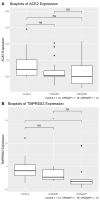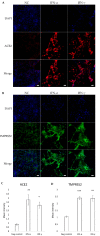Cytokine-Induced Modulation of SARS-CoV2 Receptor Expression in Primary Human Nasal Epithelial Cells
- PMID: 34357998
- PMCID: PMC8308731
- DOI: 10.3390/pathogens10070848
Cytokine-Induced Modulation of SARS-CoV2 Receptor Expression in Primary Human Nasal Epithelial Cells
Abstract
Background: Viral entry of severe acute respiratory syndrome coronavirus 2 (SARS-CoV2) via the spike protein enables endocytosis into host cells using the ACE2 receptor and TMPRSS2. The frequent upper respiratory tract symptoms of COVID-19 and the localization of the virus to the nasopharynx, the most common site of swabbing, indicate that the sinonasal mucosa may play an important role in SARS-CoV2 infection and viral replication. Methods: This paper investigates the presence of ACE2 receptor and TMPRESS2 expression in the primary human nasal epithelial cells (HNECs) from the following: chronic rhinosinusitis without nasal polyps (CRSsNP), CRS with nasal polyps (CRSwNP) and control (non-CRS) patients, and maps the expression changes when exposed to Th1, Th2, Th17-associated cytokines. Results: We found that ACE2 and TMPRSS2 expression was higher in control HNECs than CRSwNP HNECs, and that both ACE2 and TMPRSS2 were downregulated further by Th2 cytokines in CRSwNP HNECs. Conclusions: This indicates an immune dysregulated state of CRSwNP mucosa, which normally contributes to a chronic inflammatory state, and might support an altered susceptibility to SARS-CoV2 infection and transmission.
Keywords: ACE2; TMPRSS2; chronic rhinosinusitis; human nasal epithelial cells.
Conflict of interest statement
The authors declare no conflict of interest.
Figures






Similar articles
-
Distinct expression of SARS-CoV-2 receptor ACE2 correlates with endotypes of chronic rhinosinusitis with nasal polyps.Allergy. 2021 Mar;76(3):789-803. doi: 10.1111/all.14665. Epub 2020 Nov 29. Allergy. 2021. PMID: 33210729 Free PMC article.
-
Viral stimulation modulates endotype-related ACE2 expression in eosinophilic chronic rhinosinusitis.Rhinology. 2021 Oct 1;59(5):460-469. doi: 10.4193/Rhin21.001. Rhinology. 2021. PMID: 34282808
-
Inflammatory endotypes of CRSwNP and responses to COVID-19.Curr Opin Allergy Clin Immunol. 2021 Feb 1;21(1):8-15. doi: 10.1097/ACI.0000000000000700. Curr Opin Allergy Clin Immunol. 2021. PMID: 33164997 Review.
-
Fluticasone Propionate Suppresses Poly(I:C)-Induced ACE2 in Primary Human Nasal Epithelial Cells.Front Cell Infect Microbiol. 2021 Apr 26;11:655666. doi: 10.3389/fcimb.2021.655666. eCollection 2021. Front Cell Infect Microbiol. 2021. PMID: 33981629 Free PMC article.
-
COVID-19 and chronic rhinosinusitis: management and comorbidity - what have we learned?Expert Rev Clin Immunol. 2023 Jul-Dec;19(11):1399-1406. doi: 10.1080/1744666X.2023.2244673. Epub 2023 Aug 11. Expert Rev Clin Immunol. 2023. PMID: 37551742 Review.
Cited by
-
Proteomic Analysis of Mucosal and Systemic Responses to SARS-CoV-2 Antigen.Vaccines (Basel). 2023 Feb 2;11(2):334. doi: 10.3390/vaccines11020334. Vaccines (Basel). 2023. PMID: 36851212 Free PMC article.
-
TLR Signals in Epithelial Cells in the Nasal Cavity and Paranasal Sinuses.Front Allergy. 2021 Nov 22;2:780425. doi: 10.3389/falgy.2021.780425. eCollection 2021. Front Allergy. 2021. PMID: 35387020 Free PMC article. Review.
References
-
- Heurich A., Hofmann-Winkler H., Gierer S., Liepold T., Jahn O., Pöhlmann S. TMPRSS2 and ADAM17 Cleave ACE2 Differentially and Only Proteolysis by TMPRSS2 Augments Entry Driven by the Severe Acute Respiratory Syndrome Coronavirus Spike Protein. J. Virol. 2013;88:1293–1307. doi: 10.1128/JVI.02202-13. - DOI - PMC - PubMed
LinkOut - more resources
Full Text Sources
Miscellaneous

